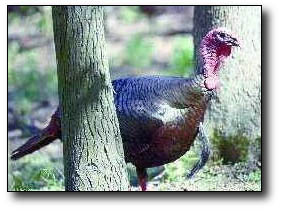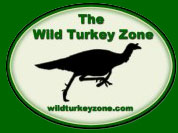|
Management
 Preferred
wild turkey habitats, especially for Eastern birds,
are large tracts of mature forests (bottomland and
upland hardwoods, pine-hardwood, pine) interspersed
with open areas (pastures, hayfields) that provide
diversity for feeding and reproduction. Turkey habitats
can often be improved through certain land management
practices. Improvements can include thinning and control-
burning pine stands, planting food plots, and creation
and maintenance of permanent grass/forbs openings
in heavily forested areas. Before implementing habitat
improvements, a landowner should determine management
objectives, inventory existing habitats, consult with
a professional wildlife biologist, and develop a comprehensive
management plan. Preferred
wild turkey habitats, especially for Eastern birds,
are large tracts of mature forests (bottomland and
upland hardwoods, pine-hardwood, pine) interspersed
with open areas (pastures, hayfields) that provide
diversity for feeding and reproduction. Turkey habitats
can often be improved through certain land management
practices. Improvements can include thinning and control-
burning pine stands, planting food plots, and creation
and maintenance of permanent grass/forbs openings
in heavily forested areas. Before implementing habitat
improvements, a landowner should determine management
objectives, inventory existing habitats, consult with
a professional wildlife biologist, and develop a comprehensive
management plan.
Forest management plans
should consider wild turkeys and other wildlife species.
Final harvest (clear-cut) areas in upland pine forests
should be restricted to 50 acres or less with maximum
feasible age differences between cutover and adjacent
stand (s). Pine stands should have a 40-year or longer
rotation length. Thinning and burning in many upland
pine types are beneficial to timber and wildlife.
Turkeys are attracted to these areas because the open
under-story promotes growth of seed-producing grasses
and legumes (important turkey foods) and increases
insect abundance.
Conversion of hardwoods
and large tracts of pine-hardwood forests to pine
plantations could decrease turkey populations. Travel
corridors and streamside management zones of older
timber should be maintained at least 300 feet wide
where clear-cutting is practiced. Small group select
or clear-cuts (up to 20 acres) in bottomland hardwood
stands can be used to regenerate hardwoods. Selective
thinnings favoring oaks, beech, wild pecan, and other
mast-producing species benefit turkeys and other wildlife.
Hickory nuts are not a favored turkey food. Dogwoods,
blueberries, huckleberries, and other fruits found
in the under-story are good turkey foods, and these
species should be protected and increased.
Suitable habitats that
did not have viable populations of wild turkeys have
been restocked with native wild birds in past years.
However, pen-reared turkeys should never be released
into the wild, since introduction of diseases and
poor genetic stock could negatively affect wild populations.
Illegal hunting (poaching)
can be a serious limiting factor. Therefore, laws
based on sound biological information regulate hunting
to protect the wild turkey population. Annual gobbler
survival rates may range from 35 to 55 percent on
heavily hunted public areas. As much as 90 percent
of all gobbler mortality occurs during the spring
hunting season. The effectiveness of regulations is
only as good as the level of enforcement given, the
degree of protection afforded turkeys by landowners,
and the ethics of hunters. Access control by gating
roads and close coordination among hunters and conservation
officers can aid in the establishment and maintenance
of wild turkey populations. Survival rates of gobblers
and jakes are not significantly different. Harvest
controls, such as not harvesting jakes, can increase
the percentage of adult gobblers. Collection of information
from gobblers harvested (weight, beard and spur length,
and age class), hen-brood surveys, and gobble counts
assists wildlife biologists in management of the wild
turkey.
Predator management is
a controversial issue in wild turkey management. Research
has indicated that viable turkey populations can generally
withstand predation if suitable habitat is provided.
However, the main limiting factor on a turkey population
in suitable habitat is predation. The decline of trapping
and hunting of furbearers has led to large increases
in these populations, which may be at or near an all-time
high. Managers might enlist the aid of hunters and
trappers to help manage turkey predators.
|

